Video of a tiny four-seat plane gliding to safety, care of its large emergency parachute, has left awed spectators asking how the life-saving device really works.
A family of three — Artem Konokuk, 38, his partner and two-year-old daughter — landed in the forests of Whitehorn, California March 8, after Konokuk realized his training flight did not have the clearance to make it over a steep tree-lined hill.
The 20-year-old plane, a Cirrus SR22, featured the Cirrus Airframe Parachute System (CAPS): a giant parachute made of bulletproof Kevlar, capable of drifting an entire single-engine craft safely down to Earth.
Once initiated, CAPS launches its parachute backward from the top of the craft at high speed, pulled by a ‘rocket motor’ powered by solid-state chemical fuel.
The young Konokuk family escaped with just cuts and bruises, which the captain of the nearby Mendocino County Sheriff’s Office described as ‘a miracle.’
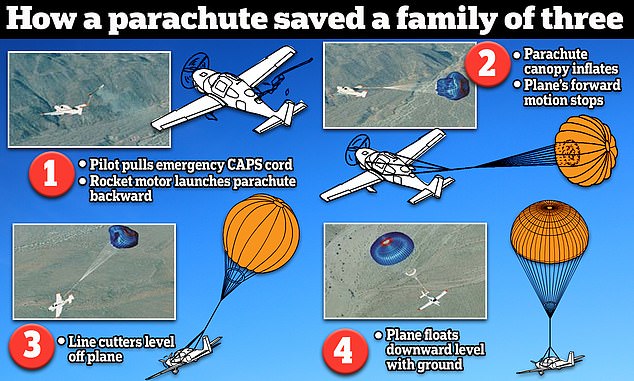
Video of a tiny four-seat plane gliding to safety, care of its large emergency parachute , has left awed spectators asking how the life-saving device really works
Cirrus’s CAPS is described as a whole-plane emergency recovery parachute system.
During an in-flight emergency, the pilot or co-pilot can deploy the solid-fuel rocket out of a concealed compartment where the parachute is stored, with just the pull of a lever.
The rocket rapidly yanks the parachute rearward from the back of the airplane, unfurling the system’s 65-foot diameter canopy in seconds.
The fabric of the parachute’s canopy is all kevlar (like bulletproof vests) and nylon, ‘woven to military specifications’ including ‘yarn count, yarn twist, weave type, and finish.’
One portion, a cloth buffer, uses teflon ‘to ensure good aging characteristics,’ the company notes — a crucial design consideration for emergency gear that may stay packed and unused for long periods.
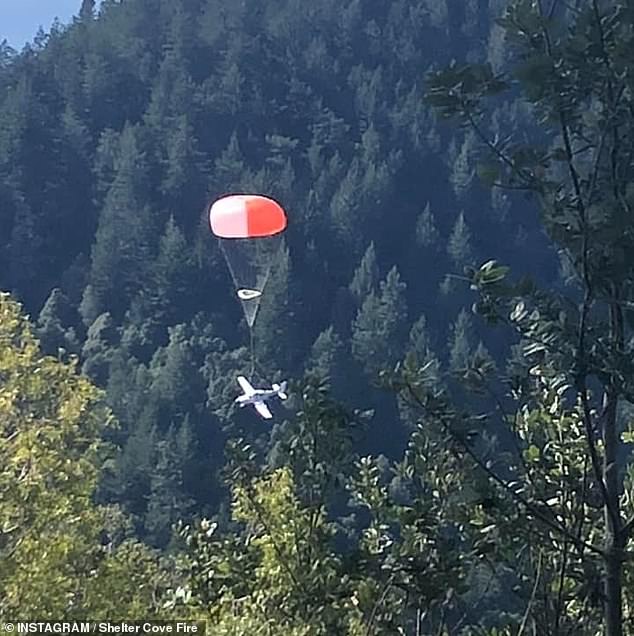
The family of three on board this Cirrus SR22 light aircraft escaped with only a few cuts and bruises when their parachute deployed over California this past Friday
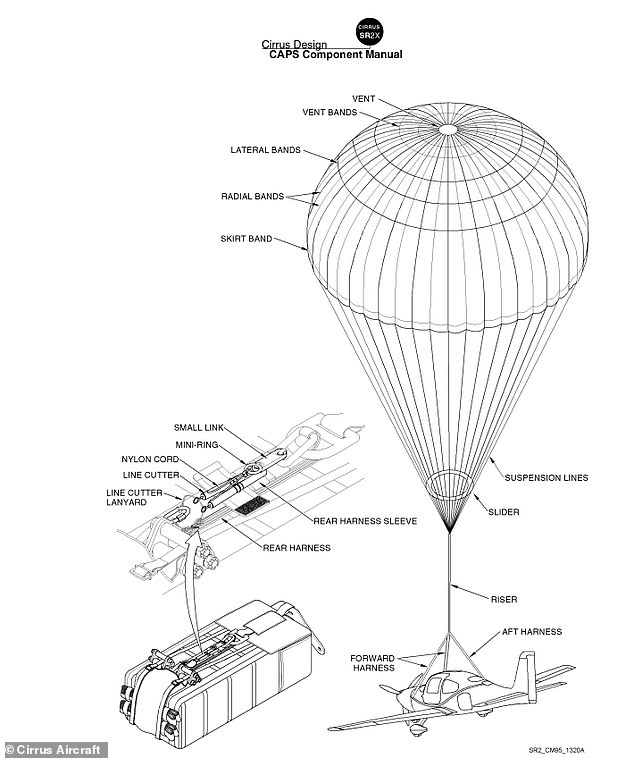
Above, a schematic from the Cirrus CAPS manual shows the packed and unfurled components of its parachute system’s assembly and the location of its line cutters

The embedded CAPS airplane parachute and its harness straps are stored within the fuselage, or the body of the plane. Eight seconds after the initial deployment, components known as ‘reefing line cutters’ reorient the parachute’s relationship to the plane
Cirrus Aircraft’s safety literature says that the chute can cut the plane’s forward velocity to zero in just eight seconds, preventing not just a ground crash, but potentially avoiding impacts with vertical surfaces like cliffs or buildings as well.
The embedded CAPS airplane parachute and its harness straps are stored within the fuselage, or the body of the plane.
Eight seconds after the initial deployment, components known as ‘reefing line cutters’ reorient the parachute’s relationship to the plane.
The line cutters bring the the aircraft to the level position underneath the parachute, from its initial ‘nose low position’ just after CAPS deployment.
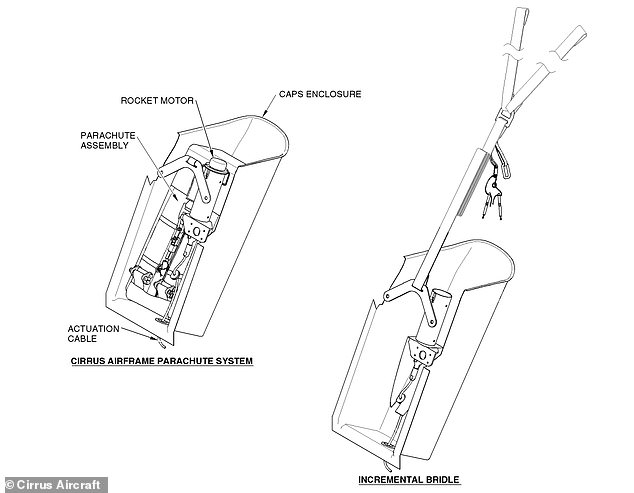
The rocket motor (above top left) carries the parachute rearward from the back of the plane, pulling the embedded CAPS airplane harness straps (right) from the fuselage or body. Within seconds, the 65ft diameter canopy unfurls, controlling the aircraft rate of descent
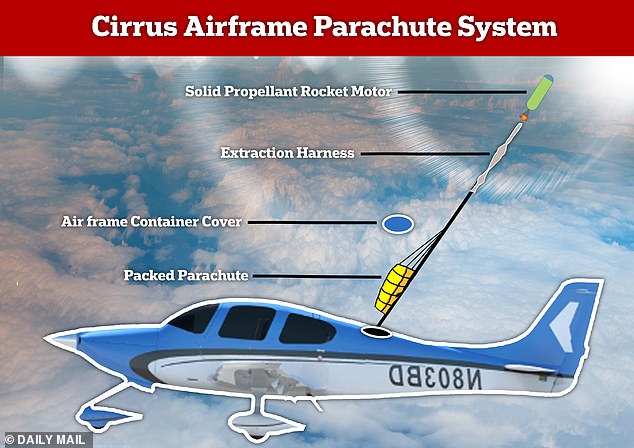
The Cirrus SR22 has a whole-plane emergency recovery parachute system, called the Cirrus Airframe Parachute System (CAPS). During an in-flight emergency the pilot can deploy a solid-fuel rocket out of a hatch that covers a concealed compartment where the parachute is stored
The shift keeps the passengers ‘right side-up’ for a safer crash landing, as opposed to a slow, but head-on collision with the ground below.
As of this time last year, March 2023, 253 survivors have been returned to their families thanks to the company’s innovative rocket-launched parachute.
Cirrus has installed parachutes for its four-seat SR22s since 1998, when it first partnered with with Minnesota-based inventor Boris Popov, creator of the ballistic aircraft parachute.
‘These are usually worst-case scenarios,’ Captain Quincy Cromer of the Mendocino County Sheriff’s Office said of the incident.
‘The fact that they had only minor scratches and abrasions is a miracle.’
Myriad first responders arrived at the wilderness crash scene Friday, according to the Los Angeles Times, including the Humboldt County Sheriff’s, California Highway Patrol, Southern Humboldt Tech Rescue and multiple local fire departments.
Rescuers watched in amazement as their single-engine plane drifted across a valley dangling helplessly below the emergency parachute before coming to rest in a tree.
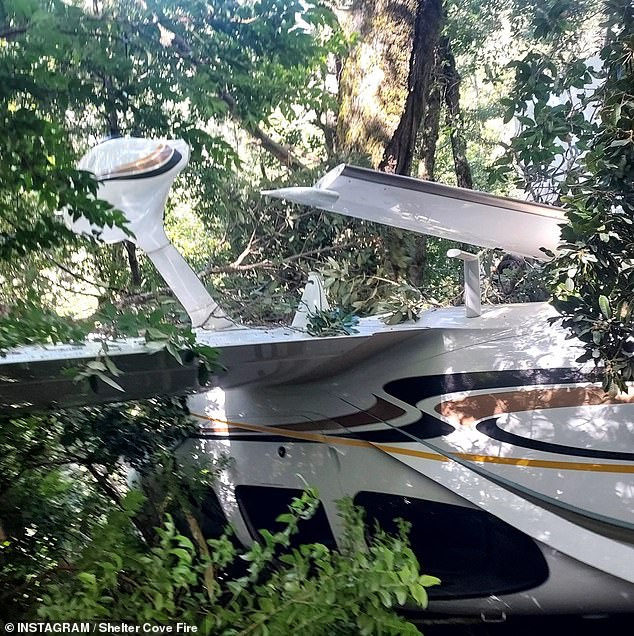
The four-seat plane came to rest in a tree before crashing to earth upside-down

The frame of the light aircraft had been torn open by the impact despite the parachute
The Konokuk family were heading on a 170-mile journey down the coast to Santa Rosa where they own a home, when the SR22’s only engine cut out at 1:15pm Friday.
‘The pilot began to troubleshoot why the airplane lost engine power,’ local sheriffs’ noted in their statement, ‘but had noticed the plane’s altitude was too low for recovery.’
‘At this point, the pilot deployed the airplane’s Cirrus Airframe Parachute System (CAPS) which slowed the airplane’s decent.’
But the family’s ordeal was far from over: The plane next came to rest caught high in the branches of a tree 100-feet above the forest floor.
‘The parachute carried the airplane until it ultimately crashed into trees in a heavily wooded area of Yellow Road in Whitethorn,’ local sheriffs said.
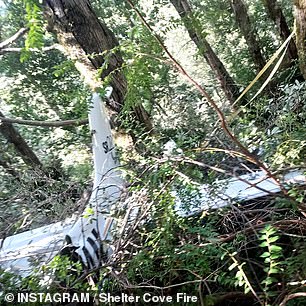
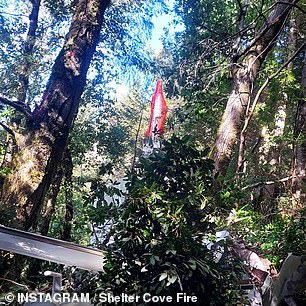
Rescuers feared the worst as they fought their way through thick forest to reach the family
Somehow, the family managed to scramble clear and climb down the tree without bringing the precipitously balanced Cirrus plane down on top of themselves.
Rescuers scrambled through the forest, arriving to discover the family safely nursing their injuries on the ground — with the 2,200-pound aircraft now twisted metal, crumpled, torn open and upside-down on the ground beside them.
Its tail was entirely detached, and the life-saving parachute was still in the tree canopy above.
Dozens of residents reported the crash to local police, some also posting what the knew to social media.
‘This happened right behind my parents home, like 75 yards away!’ wrote Amy Arnesen McOmber on Facebook.
‘The plane crashed by itself into the green belt behind their house we used to call the pipeline trail.’
Cirrus Aircraft’s co-founder Alan Klapmeier first became determined to develop a whole-plane parachute after surviving a mid-air collision in 1985.
Klapmeier was inducted into the National Aviation Hall of Fame ten years ago in recognition of his efforts.
DailyMail.com has reached out to Cirrus Aircraft’s offices across the country, as well as to the firm’s Director of Air Safety, Chris Glaeser, and its chief engineer, Paul Johnston.









